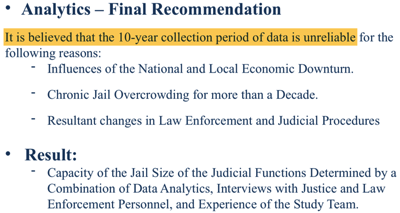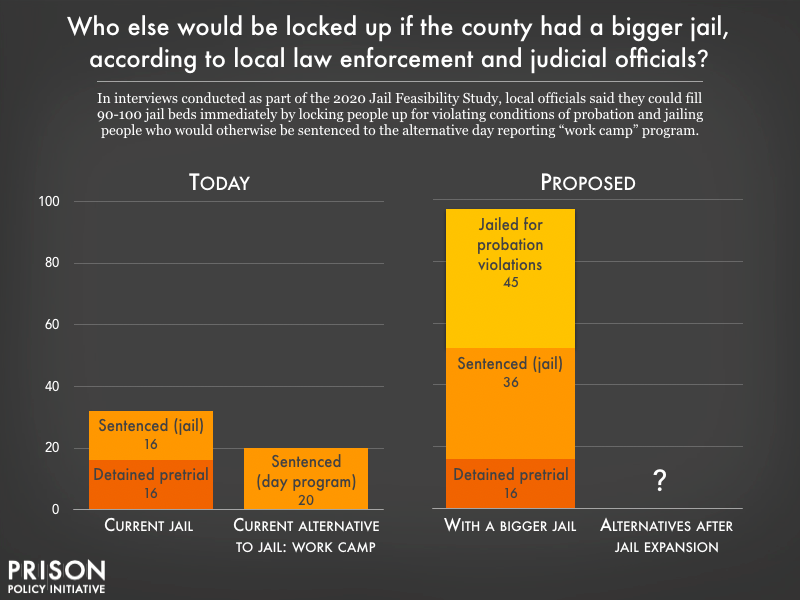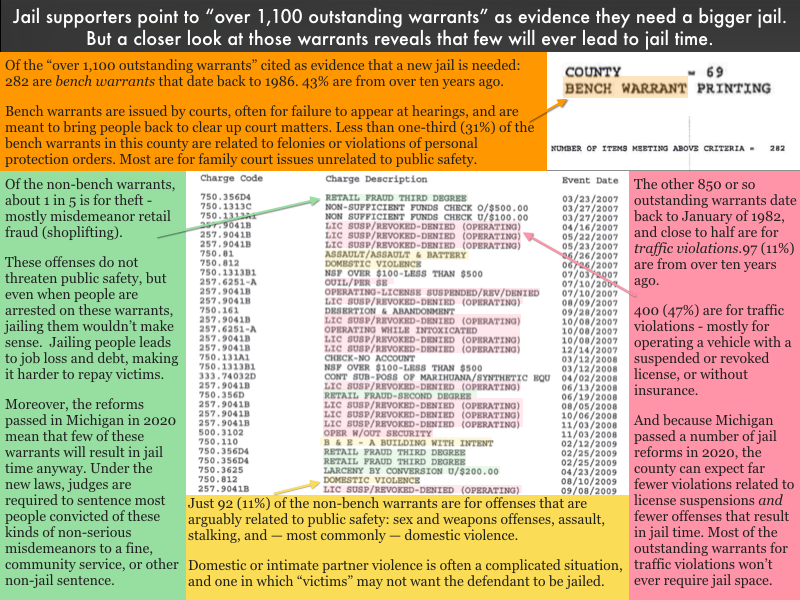Smoke and mirrors: A cautionary tale for counties considering a big, costly new jail
How law enforcement and jail architects almost duped taxpayers into approving a new jail far bigger than the county needs, by offering biased analysis and misleading arguments.
by Wendy Sawyer, July 6, 2021
We’ve called on counties before to ask the right questions before deciding to build a costly new jail, because history has shown that expanded jails are quickly filled with people who wouldn’t have been jailed before, with serious personal and community consequences. A recent jail expansion proposal in Otsego County, Michigan now shows us what happens when a county either doesn’t ask those key questions about how its jail is used – or doesn’t offer the public good answers.
Correctional, law enforcement, and court officials in Otsego County, a northern Michigan county with a population of about 25,000, have been pushing to expand their 34-bed jail for fifteen years. They’ve solicited at least three studies to evaluate local correctional systems and recommend solutions to reduce jail overcrowding. So why aren’t voters convinced of the need for a $30 million, 120-170 bed jail? We looked at the arguments offered to the public and quite simply, the arguments aren’t convincing to anyone who doesn’t build new jails or lock people up for a living.
The worst jail assessment we’ve ever seen
In its most recent attempt to justify a much-bigger jail, the county enlisted an architectural firm to conduct a “feasibility study.” The architects were not criminal justice experts – and it shows.1 The 13 pages of the report dedicated to “analysis” rationalizing the need for a bigger jail are heavy on charts and light on analysis; the 30 pages of architectural and construction plans that follow show where the authors’ expertise and priorities lie. The “Analytics” section of the report includes many charts and arguments that nevertheless fail to advance the case, including:

Sample image from the architects’ report. Why does the scale of this graph appear to change in 2019, so that 24,985 appears lower than 24,665? And why does the chart show the population at 10-year intervals except for 2018 and 2019? What is the community supposed to take away from this inscrutable chart?
- Four charts on county population projections through 2049, ostensibly meant to tie the need for a 253% increase in jail space to the county’s current 0.11% annual growth rate (and some of these charts are nonsensical, as shown in the screenshot here);
- A summary of annual court caseloads from 2008-2018, which shows a trend of decreasing caseloads over time, and also concludes “no apparent relationship to population growth” and “projection modeling does not indicate probability/necessity for future court [sic] within the study milestone periods”;
- A summary of jail bookings, average daily populations, and average length of stay from 2009-2012 and 2014-2018, showing that the jail typically operated at between 100-115% capacity before 2013, but has operated at 70-88% capacity for four out of five years since;23
- A confusing array of jail population “projection models” based on average daily populations from different years of historical data: The model that includes all nine years of past data predicts an average daily population of 29 people or less through 2049; the model based on only the three most recent years of data projects a maximum average daily population of 66 people in the jail in 2049. There is no discussion of why the county should base its plans on one model over any other, and you can probably guess what projection the authors base their recommendation on (yes, the biggest one).
- Scant attention to the composition of the jail population, making it hard to see how the jail is currently used: There is one chart about the gender breakdown of the daily population. There is no analysis of the population by offense type, sentence length, classification levels, or conviction status. The closest the report gets to evidence-based analysis of how the jail is currently used is one chart showing that, of all the people booked into the jail between 2009-2018, about half were sentenced and half were unsentenced.

The most damning sentence in the architects’ report (our highlighting added) calls the jail population data “unreliable,” even though that data makes up most of their own Analytics section.
The most telling parts of the consultants’ report are its conclusions that the jail population data are “unreliable” and “invalid,” even though those data make up most of the Analytics section. If the data are really “unreliable” or “invalid,” why did the consultants include them and make so many charts about them? Was it simply to give their recommendations the appearance of impartiality and rationality? Instead of basing their recommendations on the data available and presented to the public, the final recommendation for the new jail size is based largely on “interviews with justice and law enforcement personnel” and the “experience of the study team.” And, of course, both groups – justice and law enforcement personnel and the team of architects and engineers – stand to benefit from building a bigger jail.
Law enforcement and judicial officials complained to the consultants that, with the jail often near maximum capacity, they “have one hand tied behind their back,” and have been forced to come up with alternative sanctions instead of jailing people for all of the offenses they’d like to. Ironically, many of the alternatives officials complained about being forced to use are widely considered “best practices” today:
- Issuing citations in lieu of arrest
- Using non-carceral sanctions for violations of probation or drug court conditions
- Sentencing to an alternative-to-incarceration program, such as the drug court or the sheriff’s day reporting “work camp”
- Using restraint in prosecutorial charging decisions to avoid unnecessary incarceration
- Avoiding the misuse of the jail to lock people up for mental health or substance use disorders
Local officials often dodge the question asked by community leaders: “If we let you build a bigger jail, will you just fill it?”
In Otsego County, instead of expanding upon the alternative sanctions already in place, law enforcement and judicial officials estimated that if they had a bigger jail, they “could now have 90-100” people in jail instead of 30-40. And just who are these residents that they “can’t” lock up now, but would, if only they had a bigger jail? According to the feasibility study, these include 45 “potential probation violators” and 20 people who would – with the current system – be sentenced to the alternative work release program. Their intention is clear: if taxpayers let them build a bigger jail, they can and will fill it.

Community members have received mixed messages from local officials in response to their concerns that the new jail will immediately be filled once police have a place to book more people and judges have a place to detain and incarcerate them. In a local newspaper series about the need for a new jail, the county jail administrator said that’s “not necessarily true”: “We have great judges and I don’t see them being overzealous and automatically going to the jail commitment.” But in the same article, one of those local judges commented:
“What it comes down to is it hampers my ability to do my job, which is to protect our community by creating this deterrent effect and this punishment. If I’ve got to give this person work camp or probation, I’m not accomplishing that goal because it doesn’t have the same effect as sitting in jail for 30 or 60 days.”
It’s true that sitting in jail has a different effect than sentences that allow people to remain in the community, such as probation – but the evidence is clear that the costs of locking people up are much greater than the negligible (if any) deterrent effect of incarceration:
- A pair of studies comparing two groups of people convicted of felonies in Michigan – some sentenced to prison and some sentenced to probation – found that (1) incarceration did not reduce the likelihood of future violent crimes after release and (2) incarceration increased the odds of re-incarceration, mainly due to technical violations of post-release supervision. In other words, compared to probation, incarceration had no deterrent effect, but did lead to more incarceration for low-level offenses and violations.
- Even a short stint in jail can seriously destabilize individuals and families: In a study of people detained in jail pretrial before being released on bond, those who were jailed for three days or more were almost 2.5 times less likely to be employed, 40% more likely to struggle with housing instability, and 59% more likely to report negative impacts on their children compared to people jailed for less than three days, when surveyed after release.
- Short sentences to incarceration lead to long-term employment problems: Another study found that young people who were incarcerated after being convicted for the first time were more likely to be unemployed afterwards than similar individuals who were not incarcerated. Even though the average sentence length for the incarcerated individuals was only about four months, the effect on employment lasted for up to six years after their release.
- Jails are dangerous places, with increasingly high death rates, especially for people struggling with mental health and substance use disorders. And higher jail incarceration rates impact the health of surrounding communities, too: A recent study found that, at the county level, increasing jail incarceration rates were linked to increases in overall deaths from infectious diseases, chronic lower respiratory disease, substance use, suicide, and other causes of death. Jail incarceration is very much a public health issue.
Another bad-faith argument from jail proponents: “But we have outstanding warrants!”
In addition to the seriously flawed “feasibility study,” Otsego County law enforcement also point to “over 1,100 outstanding warrants” as evidence that they need a bigger jail. However, a closer look at those warrant details shows that only a fraction are clearly related to public safety. Additionally, many of the underlying offenses are no longer criminal or jailable under Michigan’s recent jail reforms – meaning that even with a bigger jail, very few are likely to actually lead to jail time as our closer look at the warrant list reveals:

Proponents of the Otsego jail expansion rely on some thin and out-of-date arguments to make their case. For example, they point to a summary of drug cases initiated by a regional undercover drug task force that includes Otsego County, which shows that the task force initiated an increasing number of cases in Otsego County from 2016-2019, with a high of 56 cases in 2019. That summary does not offer a detailed breakdown of these cases, but a local news report shows that in 2018, the task force’s work – across all seven counties – most typically involved prescription opiates and marijuana, which accounted for 44% of all cases that year.4 Now that Michigan has legalized recreational marijuana use, possession, and licensed sale, the county can expect few, if any, new marijuana arrests. And of course, in 2021, no one would argue that jail is any kind of solution for the prescription opioid problem.
How the county’s jail assessment went wrong and how other counties can get it right
The National Institute of Corrections – part of the U.S. Department of Justice – has a Jails Division for the express purpose of offering technical assistance, information resources, networks and training to local jail systems – including help with jail and justice system assessment and planning. Among the agency’s numerous publicly available resources is a Jail Capacity Planning Guide, which emphasizes “a systems approach.” The authors emphasize the need to look at the ways various parts of the local justice system impact a jail’s population and how the jail is used.
A “systems approach” looks closely at all the moving parts that impact jail populations, instead of focusing on those populations alone. This makes sense: Jails are just one facet of a community’s criminal justice system, and any of those facets can be changed – not just jail size:
- Laws determine which offenses are “jailable” and which should result in a citation or summons at most.
- Law enforcement use their discretion to arrest, issue citations, connect people with services, or simply let people go.
- Prosecutors make charging decisions and can offer diversion programs or decline to prosecute.
- Judges and magistrates order people detained or released pretrial, impact court processes, and make sentencing decisions.
- Court systems, including data and information sharing systems, affect how long a case takes to process, and therefore how long people are detained pretrial or before sentencing.
- Finally, jail administrators can also influence who is held in the jail, under what conditions, and for how long.
Unfortunately, the county’s “jail first” approach looked at the jail population alone as evidence of whether the jail is “big enough.” A community should get a chance to understand how all of these different parts of the system are contributing to the jail situation before taking the huge and irreversible step of sinking tens of millions of taxpayer dollars into a bigger jail that will lock up more of their own.
Conclusion and recommendations: Separating what law enforcement wants from what the community needs
The good news in Otsego County is that despite the aggressive public relations campaign launched by its proponents, taxpayers were not convinced and voted down a tax increase to pay for the new jail. But the argument will surely be back, and the whole experience is a warning to other communities.
Advocates working to prevent criminal justice system expansion should anticipate that local criminal justice officials may frame their professional wants as community needs. But law enforcement have a singular perspective on community needs, a view colored by the particular anxieties, frustrations, and mandates of their job. The power to arrest and detain is also a key tool of the trade. Police and sheriffs are bound to favor solutions that enhance those powers – including more jail space to lock people up for lower-level offenses, probation violations, failure to appear at court hearings, and “quality of life” issues (which Otsego County officials seem to hint at with a mention of the “transient” population).
But most community members do not stand to benefit from a bigger jail or the increase in arrests and detention that are certain to come with it. Yet they are the people expected to pay for the multimillion-dollar project and the hundreds of thousands of dollars in additional annual operational costs.
Of course, the community does need improvements to its justice system. It needs court matters to be resolved rather than being converted to bench warrants that hang over residents’ heads, threatening to send them to jail for offenses as minor as old traffic tickets. It needs more non-jail sanctions to respond to probation violations and low-level offenses, and yes, it needs safety improvements for jail staff, incarcerated people, and their visitors. But none of these needs requires a big, new jail. The community has also made clear, through its vote, that it wants to keep jail-related costs as low as possible, now and moving forward. Ultimately, what the community needs is an unbiased, evidence-based, affordable plan to improve their justice system, starting with an open conversation about what that means to residents versus law enforcement. In all likelihood, the community isn’t looking to lock up more people, but rather for a more robust system of alternative responses and community resources.
We recommend that any county considering a new jail should first:
- Engage the community in conversation about their public safety priorities, including a broad cross-section of community members, not just public safety and administrative officials. This conversation should consider the human costs as well as the economic costs of increasing arrests and jail detention. Any information cited by justice system officials should be provided to community members – with as much detail as possible – to analyze independently.
- Build upon the jail alternatives the county has already implemented to keep people out of jail. For example, Otsego County already operates a drug court program and an alternative to jail, the sheriff’s “work camp” (day reporting program). At least as recently as 2013, the county also used alternative sentencing such as:
- Community service in lieu of jail or fines and fees
- Frequent drug testing in lieu of jail
- Deferred or delayed sentences
- Residential treatment
- Maintaining employment or schooling in lieu of jail
- “Tether” (electronic monitoring) in lieu of jail, and
- Probation in lieu of jail
In its public relations materials advocating for a bigger jail, the county government claims that these programs are already “at capacity,” but if the county is willing to spend taxpayer money to expand the jail’s capacity, it should consider first expanding these existing programs.
- Change pretrial policies and practices that result in unnecessary jail detention. Pretrial policies have been driving jail growth for decades. Nationwide, about three-quarters of people held in jails for local authorities are not convicted of any crime, very often because they can’t afford the money bail amount required for release before trial. Pretrial detention is rarely necessary to ensure appearance in court and it causes lasting harm to defendants and their families. Counties across the country have implemented an array of reforms to reduce their pretrial populations without putting community safety at risk.
- Revisit past efforts and recommendations that have been ignored but might be effective under current circumstances. In Otsego County, past jail studies and the Master Plans developed in 2008-2013 by the Criminal Justice Coordinating Committee have recommended further solutions and alternatives that were rejected or abandoned for one reason or another, but which are worth reconsidering now. These include:
- Resurrecting a restorative justice program that was used successfully to divert prosecution in the 1970s, until the death of the key volunteer
- Trying new restorative justice programs
- Seeking additional funding for alternative programs, including by hiring a grant writer
- Establishing a mental health court, a juvenile drug court, and a peer-led teen court
- Improving court notifications
- Educating physicians about available programs to monitor prescription drugs, and
- Investing in crime prevention programs, such as community-based parenting programs, mental health counseling in schools, affordable after school programs, etc.
- Implement new programs to minimize missed court appearances and the resulting bench warrants: Many counties have begun using electronic and automatic court reminder programs that defendants can opt-in to for text message or email reminders as their court dates approach. Hennepin County, Minnesota, introduced such a program in 2017, and after the first 2.5 years of the program, defendants who received reminders were 35% more likely to appear as scheduled.
Counties can also create a bench warrant clearing process that encourages defendants who have missed court dates or outstanding fines to appear in court without fear of jail detention, and that cleans out backlogs of old warrants. “Warrant amnesty” programs operated by local courts around the country designate specific time periods during which individuals with eligible outstanding warrants can make arrangements – without arrest – to have their cases go straight to disposition by paying the original fines, participating in diversion programs, etc. The Hennepin County District Court operates a Warrant Hotline for people with outstanding warrants to schedule a hearing over the phone to take care of their case and to get more information about what options are available. In the first six months of the Hotline program, court staff fielded over 500 calls, with 85% of callers who scheduled hearings over the phone appearing in court to clear up their warrants.
- Consult a criminal justice system expert who will evaluate the jail as part of the greater local criminal justice system, not just the historical use of the jail – or worse, simple population projections. Many examples of local jail assessments are available online that demonstrate what a “systems approach” to analysis looks like, including those from Hennepin County, Minn. (2018), Macomb County, Mich. (2016), and Monroe County, Ind. (2021), which demonstrate a range of studies in terms of depth and scope. And again, the National Institute of Corrections’ Jail Division offers local jurisdictions technical assistance – including jail planning services and information.
Footnotes
-
A consultant on the Otsego study conducted by Byce & Associates, Joe Mrak, is the owner and principal of Securitecture, “an analytics company specializing in public safety buildings,” according to a 2019 article. However, a close study of Mr. Mrak’s qualifications shows that the only credentials implying any criminal justice system expertise is a CPTED certification. CPTED, which stands for Crime Prevention Through Environmental Design, is an “approach to crime prevention that uses urban and architectural design and the management of built and natural environments,” according to the International CPTED Association. For example, CPTED practitioners might recommend additional lighting or changes to landscaping in parking lots to increase visibility and thereby reduce the likelihood of assault or robbery outside of a shopping center. While CPTED certification is certainly a useful credential for architects working in the criminal justice space, CPTED is not a comprehensive approach to crime prevention and has nothing at all to do with assessing justice system processes. ↩
-
The average daily population has shifted in tandem with the average length of stay, declining from 2014-2017 and then jumping back up in 2018. These numbers are related because jail populations build up as individuals are forced to stay longer. In 2018, the average daily population jumped from 24 up to 39 people, at the same time that the average length of stay rose from 13 days to 39 days. The report does not explain the dramatic change in 2018. ↩
-
For context, in 2018, U.S. jails nationwide operated at about 81% capacity, but small jails of less than 50 people were only about 58% occupied. ↩
-
Data from the first quarter of 2019 (in the same article) showed an uptick in meth-related cases, but again, the data aren’t detailed enough to show whether these are cases that made a real dent in the availability of drugs or whether the task force was often targeting addicts with overly aggressive policing tactics, as residents of nearby Emmet County – covered by the same task force – have claimed and protested against. ↩
Acknowledgements
We thank the John D. and Catherine T. MacArthur Foundation Safety and Justice Challenge for their support of our research into the use and misuse of jails in this country. We’re also grateful to the residents of Otsego County who brought their experiences and the relevant documents provided by the County to our attention.




